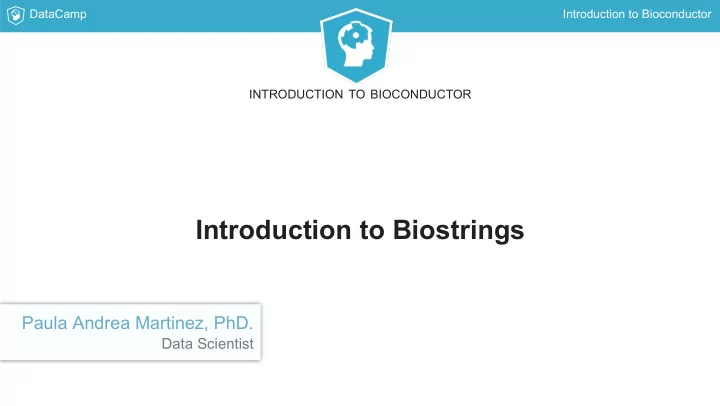

DataCamp Introduction to Bioconductor INTRODUCTION TO BIOCONDUCTOR Introduction to Biostrings Paula Andrea Martinez, PhD. Data Scientist
DataCamp Introduction to Bioconductor Biological string containers Memory efficient to store and manipulate sequence of characters Containers that can be inherited For example: The BString class comes from big string showClass("XString") showClass("BString") showClass("BStringSet")
DataCamp Introduction to Bioconductor Biostring alphabets DNA_BASES # DNA 4 bases [1] "A" "C" "G" "T" RNA_BASES # RNA 4 bases [1] "A" "C" "G" "U" AA_STANDARD # 20 Amino acids [1] "A" "R" "N" "D" "C" "Q" "E" "G" "H" "I" [11] "L" "K" "M" "F" "P" "S" "T" "W" "Y" "V" DNA_ALPHABET # contains IUPAC_CODE_MAP RNA_ALPHABET # contains IUPAC_CODE_MAP AA_ALPHABET # contains AMINO_ACID_CODE [1] For more information IUPAC DNA codes http://genome.ucsc.edu/goldenPath/help/iupac.html
DataCamp Introduction to Bioconductor
DataCamp Introduction to Bioconductor Transcription DNA to RNA # DNA single string dna_seq <- DNAString("ATGATCTCGTAA") dna_seq 12-letter "DNAString" instance seq: ATGATCTCGTAA # Transcription DNA to RNA string rna_seq <- RNAString(dna_seq) rna_seq 12-letter "RNAString" instance seq: AUGAUCUCGUAA
DataCamp Introduction to Bioconductor Translation RNA to amino acids RNA_GENETIC_CODE rna_seq 12-letter "RNAString" instance seq: AUGAUCUCGUAA # Translation RNA to AA aa_seq <- translate(rna_seq) aa_seq Three RNA bases form one AA: AUG = M, AUC = I, UCG = S, UAA = * 4-letter "AAString" instance seq: MIS*
DataCamp Introduction to Bioconductor Shortcut translate DNA to amino acids dna_seq 12-letter "DNAString" instance seq: ATGATCTCGTAA # translate() also goes directly from DNA to AA translate(dna_seq) 4-letter "AAString" instance seq: MIS* # Same result as before
DataCamp Introduction to Bioconductor The Zika virus
DataCamp Introduction to Bioconductor INTRODUCTION TO BIOCONDUCTOR Let's practice with the Zika virus!
DataCamp Introduction to Bioconductor INTRODUCTION TO BIOCONDUCTOR Sequence handling Paula Andrea Martinez, PhD. Data Scientist
DataCamp Introduction to Bioconductor Single vs set XString to store a single sequence XStringSet for many sequences BString for any string BStringSet DNAString for DNA DNAStringSet RNAString for RNA RNAStringSet AAString for amino acids AAStringSet
DataCamp Introduction to Bioconductor Create a stringSet and collate it # read the sequence as a set zikaVirus <- readDNAStringSet("data/zika.fa") length(zikaVirus) # the set contains only one sequence [1] 1 width(zikaVirus) # and width 10794 bases [1] 10794 # to collate the sequence use unlist zikaVirus_seq <- unlist(zikaVirus) length(zikaVirus_seq) # A 10794-letter "DNAString" instance [1] 10794 width(zikaVirus_seq) # Error unable to find width for "DNAString"
DataCamp Introduction to Bioconductor From a single sequence to a set # to create a new set from a single sequence zikaSet <- DNAStringSet(zikaVirus_seq, start = c(1, 101, 201), end = c(100, 200, 300)) zikaSet A DNAStringSet instance of length 3 width seq [1] 100 AGTTGTTGATCTGTGTGAGTCAGACT...AATTTGGATTTGGAAACGAGAGTTT [2] 100 CTGGTCATGAAAAACCCCAAAGAAGA...GTAAACCCCTTGGGAGGTTTGAAGA [3] 100 GGTTGCCAGCCGGACTTCTGCTGGGT...CAGCAATCAAGCCATCACTGGGCCT length(zikaSet) [1] 3 width(zikaSet) [1] 100 100 100
DataCamp Introduction to Bioconductor Complement sequence a_seq <- DNAString("ATGATCTCGTAA") a_seq 12-letter "DNAString" instance seq: ATGATCTCGTAA complement(a_seq) 12-letter "DNAString" instance seq: TACTAGAGCATT
DataCamp Introduction to Bioconductor Rev a sequence zikaShortSet A DNAStringSet instance of length 2 width seq names [1] 18 AGTTGTTGATCTGTGTGA seq1 [2] 18 CTGGTCATGAAAAACCCC seq2 rev(zikaShortSet) A DNAStringSet instance of length 2 width seq names [1] 18 CTGGTCATGAAAAACCCC seq2 [2] 18 AGTTGTTGATCTGTGTGA seq1
DataCamp Introduction to Bioconductor Reverse a sequence zikaShortSet A DNAStringSet instance of length 2 width seq names [1] 18 AGTTGTTGATCTGTGTGA seq1 [2] 18 CTGGTCATGAAAAACCCC seq2 reverse(zikaShortSet) A DNAStringSet instance of length 2 width seq names [1] 18 AGTGTGTCTAGTTGTTGA seq1 [2] 18 CCCCAAAAAGTACTGGTC seq2
DataCamp Introduction to Bioconductor Reverse complement # Original rna_seq sequence 8-letter "RNAString" instance seq: AGUUGUUG reverseComplement(rna_seq) 8-letter "RNAString" instance seq: CAACAACU # Using two functions together reverse(complement(rna_seq)) 8-letter "RNAString" instance seq: CAACAACU
DataCamp Introduction to Bioconductor
DataCamp Introduction to Bioconductor INTRODUCTION TO BIOCONDUCTOR Let's practice sequence handling!
DataCamp Introduction to Bioconductor INTRODUCTION TO BIOCONDUCTOR Why are we interested in patterns? Paula Andrea Martinez, PhD. Data Scientist
DataCamp Introduction to Bioconductor
DataCamp Introduction to Bioconductor What can we find with patterns? Gene start Protein end Regions that enhance or silence gene expression Conserved regions between organisms Genetic variation
DataCamp Introduction to Bioconductor Pattern matching matchPattern(pattern, subject) 1 string to 1 string vmatchPattern(pattern, subject) 1 set of strings to 1 string 1 string to a set of strings
DataCamp Introduction to Bioconductor Palindromes findPalindromes() # find palindromic regions in a single sequence
DataCamp Introduction to Bioconductor Not new biology The Genetic code was first described by Nirenberg in 1963 On the coding of genetic information Nirenberg, Marshall et al. Cold Spring Harb Symp Quant Biol 1963, 28 How translation might differ according to the reading frame, was first described by Streisinger in 1966 Frameshift Mutations and the Genetic Code Streisinger, George et al. Cold Spring Harb Symp Quant Biol 1966, 31: 77-84
DataCamp Introduction to Bioconductor Translation has six possibilities # Original dna sequence [1] 30 ACATGGGCCTACCATGGGAGCTACGAAGCC # 6 possible reading frames, DNAStringSet [1] 30 ACATGGGCCTACCATGGGAGCTACGAAGCC + 1 [2] 30 GGCTTCGTAGCTCCCATGGTAGGCCCATGT - 1 [3] 29 CATGGGCCTACCATGGGAGCTACGAAGCC + 2 [4] 29 GCTTCGTAGCTCCCATGGTAGGCCCATGT - 2 [5] 28 ATGGGCCTACCATGGGAGCTACGAAGCC + 3 [6] 28 CTTCGTAGCTCCCATGGTAGGCCCATGT - 3 # 6 possible translations, AAStringSet [1] 10 TWAYHGSYEA + 1 [2] 10 GFVAPMVGPC - 1 [3] 9 HGPTMGATK + 2 [4] 9 AS*LPW*AH - 2 [5] 9 MGLPWELRS + 3 [6] 9 LRSSHGRPM - 3
DataCamp Introduction to Bioconductor Conserved regions in the Zika virus Adapted figure From Mosquitos to Humans: Genetic Evolution of Zika Virus Wang, Lulan et al. Cell Host & Microbe 2016, Vol 19 5: 561-565 Facts The Zika Virus has a positive strand genome. It lives in humans, monkeys and mosquitoes. The Flaviviruses family and share 11 conserved proteins.
DataCamp Introduction to Bioconductor INTRODUCTION TO BIOCONDUCTOR Let's practice finding patterns!
Recommend
More recommend